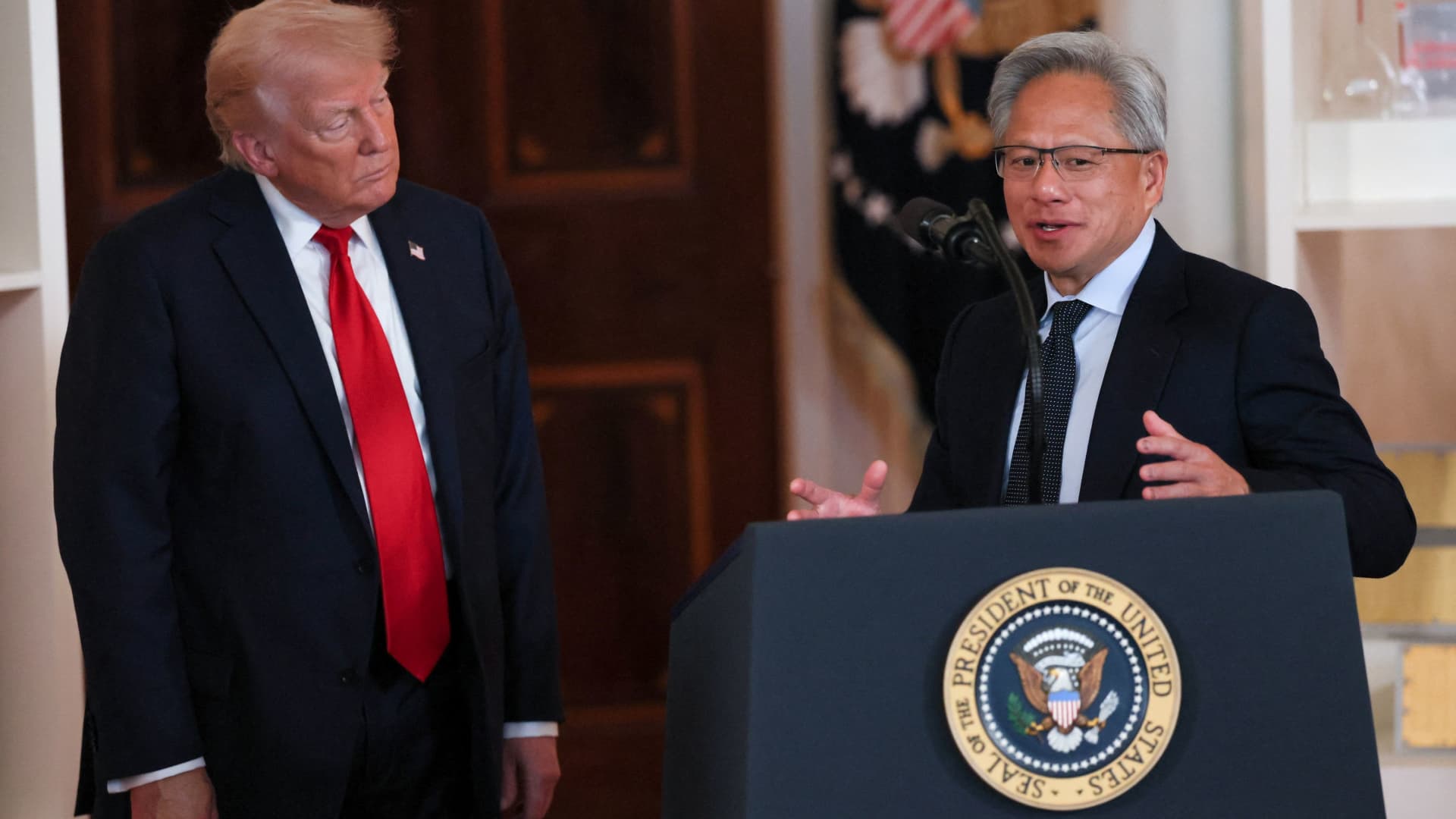Nvidia, a titan in the realms of graphics processing and artificial intelligence, stands at a critical juncture. CEO Jensen Huang’s recent meeting with former President Donald Trump at the White House, followed by a scheduled trip to China, underscores the company’s delicate balancing act in a geopolitically charged environment. This intersection of corporate strategy, political maneuvering, and technological innovation unfolds against the backdrop of Nvidia’s unprecedented market valuation, briefly surpassing $4 trillion. The implications of these events ripple across the AI industry, global trade, and the future of technological leadership.
A Strategic Meeting: Nvidia and the White House
The encounter between Jensen Huang and Donald Trump is fraught with geopolitical and economic significance. While the specifics of their discussion remain confidential, the broader context provides insight into the meeting’s potential focus areas. Trump’s historical emphasis on domestic manufacturing and technological sovereignty aligns with Nvidia’s substantial investments in U.S.-based semiconductor production. Huang has publicly emphasized Nvidia’s commitment to manufacturing advanced AI chips domestically, a stance likely to resonate with Trump’s administration. This alignment could signal a shared interest in bolstering U.S. technological independence, particularly in the face of growing competition from China.
The timing of the meeting is also noteworthy, occurring amid escalating trade tensions and concerns over China’s rapid technological advancements. Nvidia’s high-performance chips are pivotal for AI development, and the U.S. government has imposed stringent export controls to restrict their sale to China. The meeting may have served as a platform to discuss these export regulations, potential tariffs, and the delicate equilibrium between fostering innovation and safeguarding national security. Trump’s past protectionist policies, including tariffs on semiconductors, suggest that Huang sought to gauge Trump’s stance on these issues and advocate for policies that support Nvidia’s global operations while ensuring U.S. technological supremacy.
China: A Market of Opportunities and Challenges
Huang’s impending trip to China adds another layer of complexity to Nvidia’s strategic positioning. China represents a vast and critical market for Nvidia, with the company actively adapting to Chinese demand while navigating U.S. export restrictions. The development of the H20 AI chip, designed to comply with U.S. regulations for sale in China, exemplifies Nvidia’s delicate balancing act. This chip, tailored to meet Chinese market needs without violating U.S. export controls, underscores the company’s agility in a politically charged environment.
The proximity of Huang’s meeting with Trump to his China trip suggests a coordinated effort to ensure that Nvidia’s engagements in China align with U.S. strategic interests. While the trip is undoubtedly aimed at strengthening relationships with Chinese partners and exploring collaborative opportunities, Huang must navigate political sensitivities and potential risks. China’s leadership in AI adoption and deployment makes it indispensable for Nvidia’s growth, but operating in the region also entails challenges, including intellectual property concerns, regulatory uncertainties, and competition from domestic Chinese chipmakers.
The $4 Trillion Milestone: A Testament to Nvidia’s Vision
Nvidia’s brief surpassing of a $4 trillion market capitalization is a landmark achievement, cementing its status as a dominant force in the tech industry. This milestone is not merely a reflection of short-term market sentiment but a testament to Nvidia’s long-term vision and strategic execution. The company has successfully positioned itself at the forefront of several key technology trends, particularly artificial intelligence. Its GPUs are the industry standard for AI training and inference, and its software platforms, such as CUDA, are essential tools for AI developers. The surging demand for Nvidia’s products is driven by the explosive growth of AI across industries, including cloud computing, autonomous vehicles, healthcare, and finance.
Nvidia’s diversification beyond gaming into data centers, automotive, and professional visualization has strengthened its resilience and reduced reliance on any single market. Analysts predict continued growth for Nvidia, citing the sustained AI boom and the company’s robust competitive position. Some even speculate that Nvidia could be among the first companies to reach a $5 trillion or even $10 trillion market cap in the coming years. This optimism is underpinned by Nvidia’s relentless innovation, strategic investments, and ability to anticipate and shape technological trends.
Navigating the Future: Challenges and Opportunities
Despite its remarkable success, Nvidia faces significant challenges. Competition in the AI chip market is intensifying, with rivals like AMD, Intel, and numerous startups vying for market share. Geopolitical tensions could disrupt Nvidia’s supply chain or limit its access to key markets, while rapid technological advancements necessitate continuous innovation to avoid obsolescence. However, Nvidia also has substantial opportunities. The demand for AI chips is projected to grow exponentially, driven by advancements in AI applications across industries. Nvidia’s heavy investments in research and development position it to stay ahead of the curve, while its strong brand reputation and established customer relationships provide a competitive edge.
The AI revolution presents both immense opportunities and significant challenges. It has the potential to enhance productivity, create new jobs, and address global challenges, but it also raises concerns about job displacement, algorithmic bias, and the ethical implications of AI-powered systems. Nvidia’s role as a key enabler of AI technology places it at the center of these debates, with its actions shaping the future of AI’s societal impact.
Conclusion: A Pivotal Moment for Nvidia and the World
Nvidia’s strategic maneuvers, from meeting with Trump to engaging with China, all while achieving a $4 trillion market cap, highlight the complex interplay between technology, geopolitics, and economics in the 21st century. The company’s success is a testament to its technological prowess and its ability to navigate the evolving global landscape. As Nvidia continues to push the boundaries of AI and shape the future of technology, its actions will have far-reaching consequences for businesses, governments, and individuals worldwide. The stakes are high, and the world is watching.

